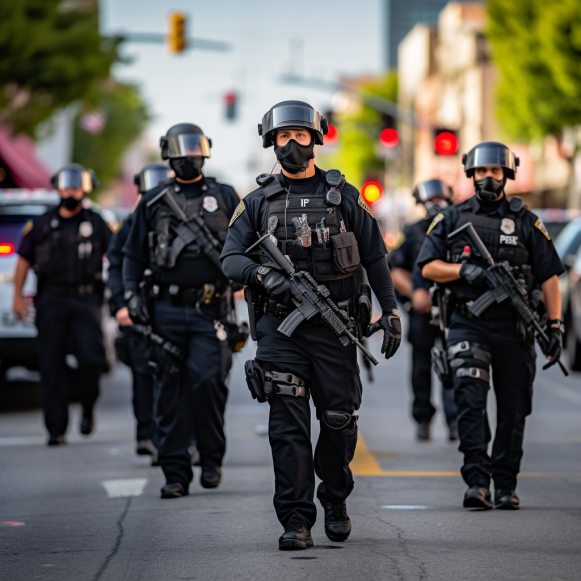San Jose police set to classify gun-pointing as a use of force
Policy change expected this month, four years after civilian police auditor urged department to join major cities in the practice
SAN JOSE, Calif. — The San Jose Police Department is expected to begin classifying instances where officers point their guns at people as a use of force four years after the city’s civilian police auditor recommended it.
Police Chief Anthony Mata wrote in a memo to the City Council that was formally reviewed Tuesday that SJPD expects to update its duty manual to include the change by the end of the month. San Jose thus joins a long list of major cities in the practice, including Oakland, San Francisco, San Diego, Los Angeles, Seattle, Denver, Washington, D.C., and New Orleans.
The memo accompanied the Office of the Independent Auditor’s 2022 annual report, which was originally scheduled to be presented to the council on June 5, but was postponed. The postponement roughly coincided with an embarrassing incident two days earlier in which former auditor Shivaun Nurre got into a loud public argument with police officers working at the San Jose Greek Festival, during which Nurre later admitted to being drunk.
Nurre informed the city of her intention to retire the following week. Karyn Sinunu-Towery, a retired Santa Clara County Assistant District Attorney who was appointed as interim auditor while the city searches for a permanent replacement, presented the annual report on Tuesday.
Officers have already been documenting when they point their firearms at people during enforcement stops and other encounters, according to Mata’s memo. However, those occurrences have yet to be considered when the department tallies and analyzes use of force incidents, despite SJPD’s support for changing that after the IPA’s office first made the recommendation in 2019.
According to the report, requiring officers to report gun pointing as a use of force is “associated with systematically reducing the rate of officer-involved shooting fatalities.” According to the report, the same research addressed a law-enforcement concern that such a policy would cause officers to hesitate to draw their firearms in dangerous situations: “Implementing this policy has no effect on the rate of gun deaths of police officers.”
“Community members have indicated that experiencing this kind of force can be traumatic and intense; the memory of the encounter can resonate for years,” the IPA’s office said in support of its recommendation. It’s terrifying and suggests the use of lethal force is imminent.”
While the police department has already been required to track gun-point incidents in order to comply with state regulations, the policy change is more than simply checking a new box on report forms. If the act is documented as a use of force, the officer may face more stringent scrutiny to ensure it was carried out in accordance with policy, which may include, but is not limited to, a review of body-camera footage and an internal-affairs investigation.
The change will almost certainly result in an increase in overall use of force incidents recorded by the department, at least in the short term. When the IPA’s office first made its recommendation in 2019, it cited a policy change in San Francisco that revealed 41% of first-quarter force reports that year involved officers pointing their guns at people.
According to the soon-to-be-adopted San Jose policy, an officer simply drawing their weapon does not constitute a documentable act as long as the weapon remains in the “low ready” position. The office defines that as being held at a 45-degree angle or less and not pointing directly at anyone.
In general, the 2022 IPA report states that the office received 358 public complaints about police conduct — the most in a decade — and that one-third of the department’s roughly 1,100 sworn officers were named in at least one complaint.
18% of those complaints had at least one sustained finding, indicating that misconduct was substantiated, a five-year high. Assistant Chief Paul Joseph stated at Tuesday’s council meeting that 2022 “was a year of unprecedented levels of misconduct at the department, something that we’re ashamed of, and something that Chief Mata has taken a hard stand on.”
In his memo, Mata also mentions that the department is working to implement several other IPA-recommended reforms. They include more robust reporting when an officer suspects someone is armed, confirms that person’s armed status, and the level of threat posed by the weapon.
The department also intends to update its duty manual to make it clear that when officers conduct an intensive search of someone, they have already committed to making a “full custodial arrest” — which in most cases means taking someone to jail. This scenario differs from more passive pat-down searches conducted during a detention that will result in a citation or release. The policy change is based on Fourth Amendment protections to prevent officers from being vague about an arrestee’s status, conducting a thorough search, and then using the results of that search to justify a subsequent arrest.
However, according to Mata’s memo, there are several exceptions, such as when people consent to a search, when someone is on probation or parole, or when there is “reasonable suspicion that the detained person is armed and dangerous.”
In addition, the department will implement a reform recommendation to provide uniform guidance when officers order someone out of their vehicle to sign a citation. Current policy defers to officers’ discretion based on their individual safety concerns, raising concerns about the practice’s equity — racial and otherwise. This policy change is expected to go into effect in November.
The final reform recommended by the IPA report is to equip officers with devices that will provide a consistent benchmark for determining whether a vehicle’s window tinting violates state law, which requires 70% of light to pass through the windshield and front side windows, and thus warrants a potential traffic stop. The adoption of this recommendation is subject to a cost assessment.






